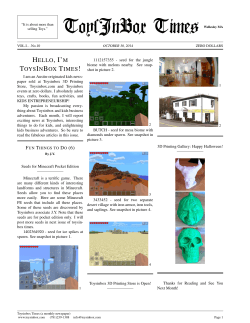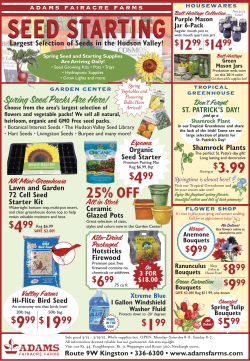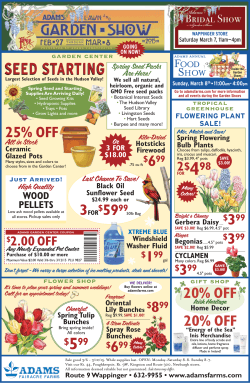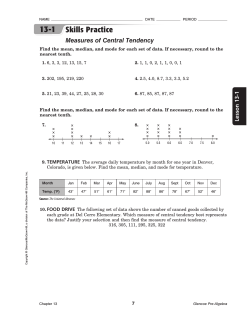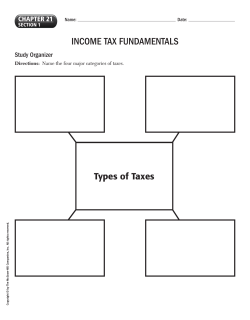
Lesson 3 | Plant Reproduction
Lesson 3 | Plant Reproduction Student Labs and Activities Page Appropriate For: Launch Lab 45 all students Content Vocabulary ELL 46 all students Lesson Outline ELL 47 all students MiniLab 49 all students Content Practice A 50 AL AL AL Content Practice B 51 AL OL BL Language Arts Support 52 all students School to Home 54 all students Key Concept Builders 55 Enrichment 59 Challenge 60 AL AL BL Lab A 63 AL AL AL Lab B 66 AL OL BL Lab C 69 AL AL BL Chapter Key Concepts Builder 70 AL AL AL Lesson Quiz A 61 AL AL AL Lesson Quiz B 62 AL OL BL Chapter Test A 71 AL AL AL Chapter Test B 74 AL OL AL Chapter Test C 77 AL AL BL AL AL AL all students Assessment Answers (with Lesson Outlines) AL Approaching Level T6 OL On Level BL Beyond Level ELL English-Language Learner Teacher evaluation will determine which activities to use or modify to meet any ELL student’s proficiency level. 44 Plant Processes and Reproduction Copyright © Glencoe/McGraw-Hill, a division of The McGraw-Hill Companies, Inc. Teacher Support Name Date Launch Lab Class LESSON 3: 15 minutes How can you identify fruits? Flowering plants grow from seeds that they produce. Animals depend on flowering plants for food. The function of the fruit is to disperse the seeds for plant reproduction. Procedure 1. Read and complete a lab safety form. 2. Make a two-column table in your Science Journal. Label the columns Fruits and Not Fruits. 3. Examine a collection of food items. 4. Place each food item on a piece of plastic wrap. Use a plastic or paring knife to cut the items in half. 5. Examine the inside of each food item. Record your observations. Determine whether each item is a fruit. Record your observations in your table. Think About This 1. What observations did you make about the insides of the food items? Would you Copyright © Glencoe/McGraw-Hill, a division of The McGraw-Hill Companies, Inc. reclassify any food item based on your observations? Explain. 2. How can the number of seeds or how they are placed in the fruit help with seed dispersal? 3. Key Concept What role do you think a fruit has in a flowering plant’s reproduction? Plant Processes and Reproduction 45 Name Date Content Vocabulary Class LESSON 3 Plant Reproduction Directions: Make a labeled drawing to represent each term below. Then answer each question or respond to each statement on the lines provided. 1. alternation of generations 2. embryo 3. Define fruit and give one example of a fruit. 4. What is mitosis? Copyright © Glencoe/McGraw-Hill, a division of The McGraw-Hill Companies, Inc. 5. Explain the relationship between an ovule and ovary. 6. What role do pollen grains play in the process of pollination? 7. Compare and contrast pistils and stamens. 8. How is a seed different from a fruit? 9. What is a spore? 46 Plant Processes and Reproduction Name Date Class Lesson Outline LESSON 3 Plant Reproduction A. Asexual Reproduction Versus Sexual Reproduction 1. Plants can 2. asexually or sexually. reproduction occurs when a portion of a plant develops into a separate new plant that is genetically identical to the parent. 3. One advantage of asexual reproduction is that just one parent organism can produce 4. . reproduction in plants usually requires two parent organisms. 5. Sexual reproduction occurs when a plant’s sperm combines with a plant’s . 6. A new plant produced by reproduction is a genetic combination of its parents. B. Alternation of Generations 1. Plants have two life stages called Copyright © Glencoe/McGraw-Hill, a division of The McGraw-Hill Companies, Inc. 2. . of is when the life cycle of an organism alternates between diploid and haploid generations. 3. Daughter cells produced from haploid structures are 4. Spores grow by . and cell division and form the haploid generation of a plant. 5. In most plants, the generation is tiny and lives surrounded by special tissues of the diploid plant. 6. Fertilization takes place when a haploid sperm and a haploid egg fuse and form a diploid . Through mitosis and cell division, the zygote grows into the generation of a plant. C. Reproduction in Seedless Plants 1. The first land plants to inhabit Earth probably were plants—plants that grow from haploid spores, not from seeds. 2. Moss plants grow by and cell division from haploid spores produced by the diploid generation. 3. The generations of ferns are the green leafy plants often seen in forests. Plant Processes and Reproduction 47 Name Date Class Lesson Outline continued D. How do seed plants reproduce? 1. Unlike seedless plants, the generation of a seed plant is located within diploid tissue. 2. A(n) forms from tissue in a male reproductive structure of a seed plant. a. Pollen grains produce b. cells. occurs when pollen grains land on a female reproductive structure of a plant that is the same species as the pollen grains. 3. The female reproductive structure of a seed plant where the haploid egg develops is called the . a. After fertilization occurs, a zygote forms and develops into a(n) , which is an immature diploid plant that develops from the zygote. b. An embryo, its food supply, and a protective covering make up a(n) . 4. Flowerless seed plants are also known as . a. The most common gymnosperms are , which are trees b. The male and female reproductive structures of conifers are called . 5. Fruits and vegetables come from , or flowering plants. a. The male reproductive organ of a flower is the . b. The female reproductive organ of a flower is the c. The . of a flower contains one or more ovules. d. Angiosperm pollen grains travel by wind, gravity, water, or animal from the anther to the , where pollination occurs. e. The ovary and sometimes other parts of a flower will develop into a(n) that contains one or more seeds. f. Fruits and seeds are important sources of for people and animals. g. When an animal eats a fruit, the fruit’s can pass through the animal’s digestive system with little or no damage. 48 Plant Processes and Reproduction Copyright © Glencoe/McGraw-Hill, a division of The McGraw-Hill Companies, Inc. and shrubs that have needlelike or scalelike leaves. Name Date MiniLab Class LESSON 3: 20 minutes Can you model the perfect flower? Minerals are natural resources that you use daily. Metal pots, ceramic dishes, and toothpaste are a few examples of things that are made from minerals. Procedure 1. Read and complete a lab safety form. 2. In the Data and Observations section below, list all the parts your flower has as an angiosperm. 3. Make a large 3-dimensional model of your new flower using chenille stems, tissue paper, construction paper, tag board, pom poms, plastic beads, scissors, and glue. 4. Check your model to make sure each flower part is in the correct proportion and shows how it interacts with other flower parts. 5. Name your flower. Create a key to identify each part and its function. Copyright © Glencoe/McGraw-Hill, a division of The McGraw-Hill Companies, Inc. Data and Observations Analyze and Conclude 1. Analyze Why do flowers have colorful petals and strong scents? 2. Infer Why does the end of the stigma feel sticky? 3. Key Concept Could your flower be self-pollinating? Explain. Plant Processes and Reproduction 49 Name Date Class Content Practice A LESSON 3 Plant Reproduction Directions: Write each word bank term in the correct location in the Venn diagram. adult conifer anther egg embryo female cone with ovule fertilization filament male cone with pollen ovary ovule pine seed pollen pollination seed sperm stamen stigma style young seedling zygote Plant Reproduction 1. Flowerless Seed Plants 2. Both 3. Flowering Seed Plants Copyright © Glencoe/McGraw-Hill, a division of The McGraw-Hill Companies, Inc. 50 Plant Processes and Reproduction Name Date Class Content Practice B LESSON 3 Plant Reproduction Directions: Answer each question in the space provided. Compare and Contrast How are they the same? Asexual and sexual reproduction in plants • How are they different? • • Diploid generation and haploid generation • • Copyright © Glencoe/McGraw-Hill, a division of The McGraw-Hill Companies, Inc. • Life cycle of a moss and of a fern • • • Flowerless seed plants and flowering Seed Plants • • • Pollen grains and ovules • • • Plant Processes and Reproduction 51 Name Date Language Arts Support Class LESSON 3 Readers’ Theater CHARACTERS: Mr. Jenkins (florist), Ms. Lee (florist), Jenny (helper), and Ileana (helper) SETTING: A florist’s workshop Mr. Jenkins: (into the phone) Thank you for your order, Ms. Gomez. We’ll have the flowers delivered to Fran’s house by two o’clock this afternoon. (hangs up the phone) Ms. Lee, can you take care of the order for Ms. Gomez? Ms. Lee: Absolutely. What kinds of flowers does she want? Jenny: Probably an arrangement just like the last one—roses, mums, and daisies with a few ferns. Ileana: What’s the difference? Plants are all alike. They all have flowers and seeds. Mr. Jenkins: I think that all plants are beautiful, each in their own way. There are so many different kinds of plants—you could never get bored with them! Ms. Lee: Actually, all of them don’t have seeds or flowers. The mosses and ferns that we use in our flower shop, for example, are seedless plants. Ileana: You’re kidding! Mr. Jenkins: Jenny, maybe you can explain plant reproduction to Ileana using what you Jenny: One important thing I learned is that plants have two life stages called generations. One generation is the diploid stage, and the other is the haploid stage. So plants go back and forth between these two stages, and that’s called alternation of generations. Ms. Lee: I never knew that. Ileana: But how do plants grow without seeds? I thought all plants grew from seeds. In my high school biology class, we learned that pollen grains form inside the stamen, which is the male reproductive structure of a plant. Plants are pollinated when these grains are transferred to the stigma, located at the top of the pistil, which is the female reproductive structure of a plant. I thought that’s the way it happened with every plant. Jenny: No, that only happens with seed plants. In those plants, the female reproductive structure contains ovules. When pollination occurs, a seed develops after an ovule is fertilized. The seed contains an embryo, along with a food supply and a protective covering. Seedless plants grow from haploid spores, not seeds. Ileana: Okay, so some plants don’t have seeds. But some plants don’t have flowers either? 52 Plant Processes and Reproduction Copyright © Glencoe/McGraw-Hill, a division of The McGraw-Hill Companies, Inc. learned in your college course in botany. Name Date Class Reader’s Theater continued Mr. Jenkins: Correct. Some plants, like moss, have no seeds and no flowers. Other plants do have seeds but they do not have flowers. These plants are called gymnosperms. The most common gymnosperms are conifers, like pine trees, firs, redwoods, or yews. They produce their male and female reproductive structures in cones, not flowers. Ms. Lee: Gymnosperms are beautiful, but everyone seems to like the flowering plants best. Jenny: Flowering plants are called angiosperms. Did you know that almost all the fruits and vegetables we eat come from angiosperms? Ileana: Really? So we just ate angiosperms for lunch? Jenny: We sure did. Fruits develop from the ovaries of flowering plants. After pollination occurs, a pollen tube grows down from the pollen grain to the ovary at the base of the pistil. Sperm develop from a haploid cell in the pollen tube, and when they enter an ovule, the sperm are released and fertilization takes place. Mr. Jenkins: After fertilization occurs, a zygote forms and develops into an embryo. The embryo, inside its ovule, becomes a seed. Ms. Lee: That’s right, and remember that an ovary contains one or more ovules. So the ovary develops into a fruit that contains one or more seeds. Peapods, tomatoes, peppers, avocados, and walnuts are fruits! Copyright © Glencoe/McGraw-Hill, a division of The McGraw-Hill Companies, Inc. Jenny: And then the seeds can grow into new plants, so the cycle starts over again. Ileana: Wow, I didn’t realize that plants are so interesting. Jenny: Now that we’ve had our botany lesson, let’s get to work and put some of these beautiful plants into an arrangement for Fran’s birthday! Plant Processes and Reproduction 53 Name Date Class School to Home LESSON 3 Plant Reproduction Directions: Use your textbook to answer each question or respond to each statement. 1. The life cycle of all plants includes an alternation of generations. What is an alternation of generations? 2. Seedless plants can reproduce from spores. Describe the life cycle of a moss plant. Include a description of the haploid and diploid stages of its life cycle. Compare and contrast the structures that common gymnosperms and angiosperms use for reproduction. 4. Flowering plants create seeds surrounded by a fruit. Identify some of the different types of fruits produced by flowering plants and explain how humans and animals help spread the seeds inside them. 54 Plant Processes and Reproduction Copyright © Glencoe/McGraw-Hill, a division of The McGraw-Hill Companies, Inc. 3. Seed plants reproduce as gymnosperms or angiosperms. Name Date Class Key Concept Builder LESSON 3 Plant Reproduction Key Concept What is the alternation of generations in plants? fertilization sperm diploid zygote diploid plant haploid spores meiosis egg haploid plant Directions: Use the diagram to answer each question on the lines provided. 1. What happens during fertilization? Copyright © Glencoe/McGraw-Hill, a division of The McGraw-Hill Companies, Inc. 2. What forms as a result of fertilization? 3. What happens in certain cells in the reproductive structures of a diploid plant? 4. What are the daughter cells produced from the haploid structure called? 5. How do haploid spores grow to form the haploid generation of a plant? 6. What do certain reproductive cells of the haploid generation produce? 7. When does the diploid generation in plants begin? 8. When does the haploid generation in plants begin? 9. Does the diagram show sexual or asexual reproduction? How do you know? Plant Processes and Reproduction 55 Name Date Class Key Concept Builder LESSON 3 Plant Reproduction Key Concept How do seedless plants reproduce? Directions: One each blank, write the term or phrase that correctly completes each sentence. 1. The first plants to inhabit Earth most likely were . 2. Two examples of seedless plants found on Earth today are and . 3. The life cycle of a fern is an example of generations. 4. The diploid generation of ferns looks like green 5. In ferns, haploid . are produced by the diploid generation. 6. Haploid plants produce and . 7. Reproduction in ferns and mosses includes the alternation of . 8. Like ferns, mosses are another example of a(n) plant. 10. Haploid plants grow by plants. and 11. Haploid spores have . structures and structures. 12. Male structures produce . 13. Female structures produce . 14. When eggs and sperm unite, they form the 15. Mosses and ferns are usually found in . environments. 16. For sperm produced by mosses and ferns to reach a(n) , they must swim through a film of water. 17. The process during which a nucleus and its contents divide is called . 18. Seedless plants are plants that grow from instead of from seeds. 56 Plant Processes and Reproduction Copyright © Glencoe/McGraw-Hill, a division of The McGraw-Hill Companies, Inc. 9. Moss found on rocks, bark, and soil are Name Date Class Key Concept Builder LESSON 3 Plant Reproduction Key Concept How do seed plants reproduce? Directions: On the line before each statement, write T if the statement is true or F is the statement is false. If the statement is false, change the underlined word(s) to make it true. Write your changes on the lines provided. 1. Most land plants that cover Earth are seedless plants. 2. Seed plants include flowerless seed plants and haploid seed plants. 3. The haploid generation is within the diploid tissue in a seed plant. 4. Haploid sperm and haploid eggs join during fertilization. Copyright © Glencoe/McGraw-Hill, a division of The McGraw-Hill Companies, Inc. 5. Pollen grains form from tissue in the male reproductive structure of seed plants. 6. Pollen grains have soft, protective coverings. 7. Eggs are produced from pollen cells. 8. Pollen cells are transported by wind, animals, gravity, and water currents. 9. Only a few pollen grains are produced by male reproductive structures. 10. Pollination occurs when pollen grains land on a female reproductive structure of the same species. 11. For pollination to occur, the sperm and eggs must be of the same species. 12. Sperm enter the embryo following pollination. Plant Processes and Reproduction 57 Name Date Class Key Concept Builder LESSON 3 Plant Reproduction Key Concept How do seed plants reproduce? Directions: Answer each question or respond to each statement in the space provided. Gymnosperm Angiosperm 2. What is an angiosperm? 3. What can be said about the seeds of gymnosperms? 4. Why do many animals depend on angiosperms for food? 5. Draw a diagram showing reproduction in flowerless seed plants. 6. Draw a diagram showing the male and female parts of an angiosperm. 7. Describe the life cycle of a gymnosperm. 8. Describe the life cycle of an angiosperm. 58 Plant Processes and Reproduction Copyright © Glencoe/McGraw-Hill, a division of The McGraw-Hill Companies, Inc. 1. What is a gymnosperm? Name Date Enrichment Class LESSON 3 Seeds on the Move The one time in the lives of most plants that they will move any significant distance is during the seed stage. Seeds are more likely to grow when they travel away from the parent plant. Over time, plants and seeds have developed adaptations that help seeds move. There are several different strategies for seed dispersal. than pollen grains, so they need a little assistance to stay airborne until a breeze takes them aloft. One adaptation for seed flight is wings. These are not wings that flap, but gossamer structures that fan out from the seed, designed to catch the wind. The seeds of a red maple are perfectly shaped to cause seeds to spin like tiny helicopters as they drop to catch the wind. Animal Food Animals that eat fleshy fruits usually swallow the seeds, too. A swallowed seed travels through the digestive system and is deposited, covered in fertilizer. An example of this type of seed dispersal is when a bird has eaten blackberries. Copyright © Glencoe/McGraw-Hill, a division of The McGraw-Hill Companies, Inc. Hitching a Ride Some seeds have outer coats that are hard, abrasive, or heavily barbed with hooks on the end of sharp spines. These seeds readily snag onto a passing animal’s fur or person’s clothing. Animals often become irritated when there are too many burrs stuck to them. When you see deer rubbing against trees or wallowing in the dirt, they are probably trying to dislodge sticky seeds, such as burdock and cockleburs. Wind and Flight Plans Like pollen, some seeds are carried by wind. Seeds are generally larger and heavier Explosions and Shakers Some plants produce seeds in pods that develop tensions throughout the pod as the seeds develop. All it takes is a nudge from an insect, a breeze, or the brush of an animal to make the pod crack open and fling seeds in many directions. Peas and touch-me-nots do this. Other seeds like poppies develop in a hard pod with tiny holes. As the wind shakes the pod, the seeds fall like pepper from a shaker. Drop and Roll or Float Many seeds are too large to fly on the wind, or they are not tasty. Some seeds are too high in the plant for animals to reach. When a horse chestnut drops, for example, its case might crack open, allowing the seed to roll away from the plant. Some seeds such as coconuts and mangrove seeds can drop into or near water, and they float away with the tide. Applying Critical-Thinking Skills Directions: Respond to each statement. 1. Name three mechanisms of seed dispersal. 2. Describe how the dispersal of seeds by animals is a mutually beneficial relationship. 3. Assess the benefits of seeds traveling away from the parent plant. Plant Processes and Reproduction 59 Name Date Challenge Class LESSON 3 Is it a fruit or a vegetable? Some people say that if it is sweet, it is a fruit and that if it is not sweet, it is a vegetable. Should that be enough to satisfy a scientist? No, but it might satisfy a chef. There is a scientific definition for fruit, but vegetable is a cooking term. Scientifically, fruit is the ripened ovary of the flower of a seed-bearing plant. Fruits contain seeds, often surrounded by a fleshy pulp and/or a seed case. A nut is botanically a fruit. What we call vegetables are just the edible parts of a plant that are not the seed parts. In everyday language, we call them vegetables, but botanically they are roots (carrots), leaves (spinach), stems (celery), and tubers (potatoes). Distinguish between Fruits and Vegetables Research each of the foods below. Then draw each food, color and label your drawing, and write a sentence about each one that explains whether it is a vegetable or a fruit and why. Labels may include fleshy pulp, stem, leaf, tuber, root, fruit, seed, vegetable or another label. 2. Squash 3. Avocado 4. Garlic 5. English peas 6. Asparagus 60 Copyright © Glencoe/McGraw-Hill, a division of The McGraw-Hill Companies, Inc. 1. Tomato Plant Processes and Reproduction
© Copyright 2025
